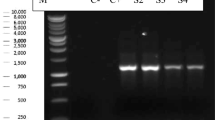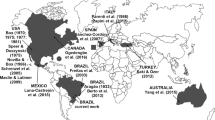Abstract
A survey was conducted on 30 Danish mink farms from April to October 2016 to determine the prevalence and species of Eimeria in Danish farmed mink. In total, 2.6% of mink faecal samples (108/4140) were positive for Eimeria vison-like oocysts by microscopy, with 24.8% (78/315) of mink being positive at least once during the study period. Morphological analysis of sporulated oocysts (n = 20) identified Eimeria vison-like oocysts measuring 21.0 × 13.8 μm with a length/width (L/W) ratio of 1.5. Phylogenetic analysis of 18S rRNA sequences (1221 bp) from three positive mink indicated that Eimeria vison-like shared the highest genetic similarity to Eimeria sp. ex Apodemus agrarius from a Striped field mouse (A. agrarius) from the Czech Republic (99.6%). Analysis of a shorter region of 18S (531 bp) revealed that the E. vison-like genotype sequences grouped in the same clade and shared 97.7% similarity with E. furonis. At the cytochrome c oxidase subunit I (COI) locus, mink-derived sequences were not available from GenBank and phylogenetic analysis placed the novel E. vison-like in a clade with E. cf. ictidea (99.4% similarity) from a black footed ferret (Mustela nigripes) from Canada.



Similar content being viewed by others
References
Abe N, Tanoue T, Ohta G, Iseki M (2008) First record of Eimeria furonis infection in a ferret, Japan, with notes on the usefulness of partial small subunit ribosomal RNA gene sequencing analysis for discriminating among Eimeria species. Parasitol Res 103:967–970
Anon (2017a) Mink. In: Landbrug og Fødevare, viden om landbrugsproduktion
Anon (2017b) Avlstæver og avlsresultater. http://www.kopenhagenfur.com/da/minkavl/historisk-data/avlstaever-og-avlsresultater. Accessed 19 Sep 2017
Chriél M, Hansen MS, Holm E, Larsen G, Hjulsager, CK (2013) Rystemink. Faglig årsberetning by Kopenhagen Fur, pp 117–120
Duszynski DW, Couch L, Upton SJ (2000) Coccidia of the world. http://www.k-state.edu/parasitology/worldcoccidia/CARNIV2? Accessed 19 Sep 2017
Gräfner G, Graubmann HD, Dobbriner W (1967) Hepatic coccidiosis in minks (Lutreola visono Schreb.) caused by a newly identified species of coccidiae (Eimeria hiepei n. Sp.). Monatsh Veterinarmed 22:696–700
Hammer AS, Andersen TH, Dietz HH (2004) Forekomsten af coccidier i danske farm mink indsendt til diagnostiske undersøgelser. Kopenhagen Fur, Faglig årsberetning, pp 223–228
Hansen S, Krarup LI, Hammer AS (2016) Er det diarré? Dansk Veterinærtidskrift 10:33–35
Hindsbo O, Andreassen J, Nielsen F, Lodal J (1995) Occurence of the coccidia Isospora laidlawi and Eimeria vison in Danish farm mink, 1987–1993; age related resistance to the infection. Scientifur 19:231–237
Hoare CA (1927) On the Coccidia of the ferret. Ann Trop Med Parasitol 21:313–320
Hoare CA (1935) The endogenous development of the Coccidia of the ferret, and the histopathological reaction of the infected intestinal villi. Ann Trop Med Parasitol 29:111–122
Iwanoff-Gobsem, PS (1934) Zum Vorkommen von Coccidien bei kleinen wilden Saugetieren. Deutsche Tierrarztlliche Wochenschrift 149–151
Jolley WR, Kingston N, Williams ES, Lynn C (1994) Coccidia, Giardia sp., and a Physalopteran nematode parasite from black-footed ferrets (Mustela nigripes) in Wyoming. J Helminthol Soc Washingt 61:89–94
Kingscote AA (1934) Eimeria mustelae, n. sp. from Mustela vison. J Parasitol 20:252–253
Kvičerová J, Hypša V (2013) Host-parasite incongruences in rodent Eimeria suggest significant role of adaptation rather than cophylogeny in maintenance of host specificity. PLoS One 8:e63601
Levine ND (1948) Eimeria and Isospora of the mink (Mustela vison). J Parasitol 34:486–492
McTaggart HS (1960) Coccidia from mink in Britain. J Parasitol 46:201–205
Roepstorff A, Nansen P (1998) Epidemiology, diagnosis and control of helminth parasites of swine. FAO animal health manual, Rome
Sledge DG, Bolin SR, Lim A, Kaloustian LL, Heller RL, Carmona FM, Kiupel M (2011) Outbreaks of severe enteric disease associated with Eimeria furonis infection in ferrets (Mustela putorius furo) of 3 densely populated groups. J Am Vet Med Assoc 239:1584–1588
Tenter AM, Barta JR, Beveridge I, Duszynski DW, Mehlhorn H, Morrison DA, Andrew Thompson RC, Conrad PA (2002) The conceptual basis for a new classification of the coccidia. Int J Parasitol 32:595–616
Yang R, Brice B, Ryan U (2016) Morphological and molecular characterization of Eimeria purpureicephali n. Sp. (Apicomplexa:Eimeriidae) in a red-capped parrot (Purpureicephalus spurius, Kuhl, 1820) in Western Australia. Int J Parasitol Parasites Wildl 5:34–39
Yang R, Fenwick S, Potter A, Elliot A, Power M, Beveridge I, Ryan U (2012) Molecular characterization of Eimeria species in macropods. Exp Parasitol 132:216–221
Yang R, Murphy C, Song Y, Ng-Hublin J, Estcourt A, Hijjawi N, Chalmers R, Hadfield S, Bath A, Gordon C, Ryan U (2013) Specific and quantitative detection and identification of Cryptosporidium hominis and C. parvum in clinical and environmental samples. Exp Parasitol 135:142–147
Acknowledgements
We thank the participating mink farmers for their support and providing faecal samples throughout the study. The authors also thank Boi Tien Thi Pharm and Aleksandra Tofteby for their skilled technical assistance with analysing the faecal samples.
Funding
This project was funded by the Pelsdyrafgiftsfonden 2016 (www.pelsdyrafgiftsfonden.dk/media/167031/vedt_gter_20-04-12.pdf). Pelsdyrafgiftsfonden is a levy fund, according to law order no. 445, 23 April 2010. The objective of the fund is to support research, with the aim to enable a more sustainable fur production. The fund did not interfere in the study design, data collection, data analysis or the interpretation of the results.
Author information
Authors and Affiliations
Corresponding author
Ethics declarations
Conflict of interest
The authors declare that they have no conflict of interest.
Rights and permissions
About this article
Cite this article
Petersen, H.H., Yang, R., Chriél, M. et al. Morphological and molecular characterisation of Eimeria vison-like oocysts (Apicomplexa:Eimeriidae) in farmed mink (Neovison vison) in Denmark. Parasitol Res 117, 2933–2939 (2018). https://doi.org/10.1007/s00436-018-5989-1
Received:
Accepted:
Published:
Issue Date:
DOI: https://doi.org/10.1007/s00436-018-5989-1




